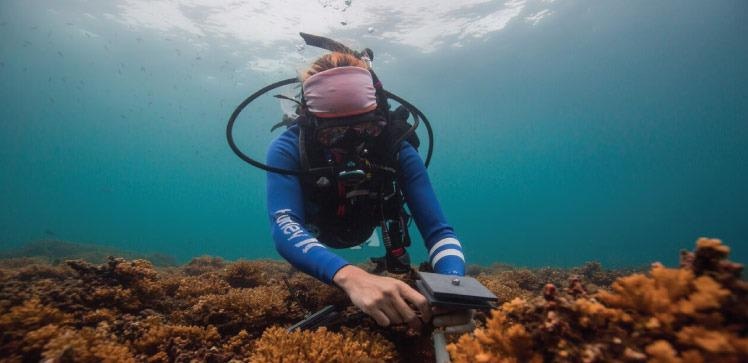Marine scientists could benefit from a blueprint that helps them quantify calcium carbonate on the ocean floor. Also, it aids in tracking the health of coral reefs throughout the world.
 Marine scientist Maggie Johnson (pictured) is implementing a method to measure calcium carbonate production in coral reefs, which is a proxy for coral reef health. Image Credit: © 2022 KAUST; Sean Mattson.
Marine scientist Maggie Johnson (pictured) is implementing a method to measure calcium carbonate production in coral reefs, which is a proxy for coral reef health. Image Credit: © 2022 KAUST; Sean Mattson.
Numerous marine habitats, especially coral reefs, are altering in an irreversible manner as a result of climate change and pollution caused by human activities. To evaluate and reduce future impacts, there is a need for ecologists to comprehend how these ecosystems are working at present.
Coral reef health could be determined by the sign of how much calcium carbonate is produced with respect to time as skeletons and shells of marine animals tends to house on the ocean floor. On a regular basis, researchers utilized unique tiles on the seabed, which slowly became the home of subsiding pioneering animals and plants.
After one year, the scientists regained the tiles to note how much calcium carbonate was housed on them and which living species are existing.
To understand how marine ecosystems are changing over space and time we need to be able to compare data collected from different habitats. But researchers employ a range of approaches or measure different variables, meaning that the data might not be directly comparable.
Maggie Johnson, Marine Scientist, King Abdullah University of Science and Technology
This phenomenon makes it difficult to make a global picture of marine ecosystem health.
Johnson and her collaborators have come up with a standardized technique for making and unfurling calcification accretion units (CAUs). These are similar to settlement tiles but more particularly are used for quantifying calcium carbonate.
The extensive “how to” guide offers elaborate instructions for tile construction and CAU assembly, right from material suppliers to measurements, as well as how to position them and recover them. All of these will allow scientists to gather equivalent data from oyster and coral reefs throughout the world.
Coral reefs cover less than one percent of the seafloor, yet provide more than 25 percent of the ocean’s biodiversity. Much of this diversity comes from tiny critters living in the unseen cracks and crevices. During collection, the tiles must be placed in zipped bags to keep the community of cryptic critters intact all the way to the lab.
Maggie Johnson, Marine Scientist, King Abdullah University of Science and Technology
It is not possible to capture such hidden species, or so-called “cryptic taxa,” by visual surveys. However, the CAUs consist of a small space for such small taxa to be occupied.
The guide informs instant processing of the samples, while the plants and animals are still alive. This includes taking high-resolution photographs that are utilized later for spotting species and microscope observations for baby coral to be counted. Furthermore, the calcium carbonate is removed with the help of a weak acid.
By weighing the tiles before and after decalcifying them, researchers can calculate how much calcium carbonate was deposited on that tile over a year. This figure can help compare reef conditions in different parts of the world or how the health of one reef is changing over time.
Maggie Johnson, Marine Scientist, King Abdullah University of Science and Technology
Comprehending the effects of human activities on marine habitats will help scientists and governments determine approaches to reduce the negative effects.
“This standardized and accessible approach will help promote collaboration and informed decision-making even when using data from all over the world,” concluded Johnson.
Checking coral reef health one tile at a time
Monitoring and comparing geographically distant coral reefs is now possible using a standardized method for measuring calcium carbonate. Video Cap: © 2022 KAUST; Maggie Johnson.
Journal Reference:
Johnson, M. D., et al. (2022) Calcification accretion units (CAUs): A standardized approach for quantifying recruitment and calcium carbonate accretion in marine habitats. British Ecological Society. doi.org/10.1111/2041-210X.13867.